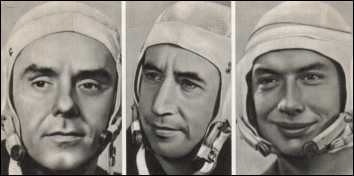
In any case this historic flight convinced me to finally buy my first short-wave radio for tracking Soviet spacecraft. The money for the radio I had earned as a rocket assembly technician during sounding rocket launches in the north of Sweden.
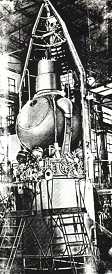 The
origins of Voskhod
The
origins of VoskhodFrom the written record it is hard to judge how the idea of a three-man flight came up. On the surface it seems that an order was received "from above" on 4 February 1964 to carry out a three-man flight in order to upstage the U.S. Gemini flights and to temporarily hide the fact that the USSR was falling behind in the space race (8). Kamanin's notes (8) seem to indicate that the plan for a three-man flight was invented in discusssions between Korelev, Ustinov15 , Smirnov16, and Keldysh18.
In any case, the pace of Voskhod, once the basic decision was taken, was breathtaking as can be seen from short listing of major dates:

The State Commission met at Baikonur in the evening of 29 September and received the news of problems with the Tral telemetry system of Voskhod. Designer Bogolomov (10) reported that the spacecraft had to be dismantled to replace the system and this would take 6-7 days. (8)
The cosmonaut group training for the flight (Komarov, Feoktistov, Yegorov, Katys, Lazarev, Volynov, Sorokin?) arrived at Baikonur on 4 October to witness the unmanned test flight of Voskhod. In the evening of 5 October the State Commission decided to launch the test flight carrying two "mannequins" the following day. At this time the cosmonaut group was not aware of who was going to be the crew of Voskhod. (8)
Kosmos-47 (64-062A) was launched into orbit at 0700 UT on 6 October and flew for 24 hours just like the upcoming manned flight. It entered a 177-413 km orbit at 64.8 degree inclination, and TASS announced a frequency of 19.994 MHz. The capsule was returned to Baikonur on 8 October for examination. A mere four days before the manned flight! Korolev was certainly operating with small margins. It was important to get the manned flight off promptly because tracking ships in the Pacific and Indian Ocean only had supplies that would allow them to remain "on station" up until mid-October! (9)
The plan was to launch Voskhod-1 on 10 October 1964, but on 8 October the news arrived from ground tests of the third stage engine that it had suffered high-frequency oscillations in the combustion chamber. The engine was being tested by the Kosberg Design Bureau (OKB-154) and had been flown many times without problems. The prevailing view was that the oscillations were caused by the effects of the test stand and designer Kosberg reported this conclusion to the State Commission meeting at Baikonur on 9 October. At this meeting Korolev also described the successful landing tests at Feodosia and the successful test flight of Kosmos-47. (8) Also, at this meeting, the cosmonauts were probably told who would actually fly the mission! (9)
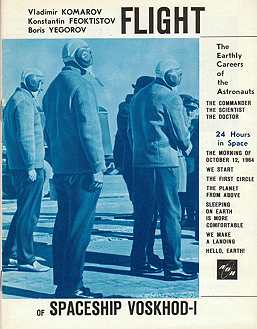 But
even with this problem cleared there was additional trouble in the
evening
before launch. The
Tral
telemetry transmitter in the booster malfunctioned
and had to be replaced, an operation that took at least two hours.
According
to Kamanin (8) Sergei Korolev completely
lost
his temper when he received this report and took quite a while before
he
could compose himself and telephone defence minister Ustinov15
to report that Voskhod-1 was ready to fly.
But
even with this problem cleared there was additional trouble in the
evening
before launch. The
Tral
telemetry transmitter in the booster malfunctioned
and had to be replaced, an operation that took at least two hours.
According
to Kamanin (8) Sergei Korolev completely
lost
his temper when he received this report and took quite a while before
he
could compose himself and telephone defence minister Ustinov15
to report that Voskhod-1 was ready to fly.
 The
mission finally gets off
The
mission finally gets offThe flight was launched at 0730 UT on 12 October 1964 and it took 523 seconds (8 minutes 43 seconds) to reach orbit. A UPI wire at 0846 UT read: "THE SOVIET UNION TODAY LAUNCHED THE WORLD'S FIRST PASSENGER SPACE SHIP WITH THREE MEN ABOARD, AUTHORITATIVE UNOFFICIAL SOURCES SAID". Shortly thereafter the launch was announced by famous Soviet radio announcer Yuri Levitan (listen here). The spacecraft had entered an orbit between 178 and 408 km at an inclination of 64.9 degrees - just as planned. Moscow announced that spacecraft weighed 5320 kg. Manual control tests and TV transmissions took place on revolution 6 and 7 (3). TV images from Voskhod were relayed to west European viewers by Eurovision at 1100 UT. Nikita Khrushchev and Anastas Mikoyan, both members of the Soviet leadership, spoke to the crew at 1400 UT (listen here) (4). Kruschchev told the crew that "Anastas Mikoyan is standing next to me and is eager to take the telephone receiver from me". This was later interpreted as symbolic of Mikoyan's participation in the plot to oust Khruschchev (see below).
On the second orbit (rev 1 in US Space Command parlance), the crew sent greetings to the Olympic Games as the craft passed near Japan around 0920. (Listen to the message here).
"On the morning of Monday, October 12, the group tuned in on 19.995 Mc/s after reading newspaper reports that a Soviet manned space flight was believed to be imminent. Mr Perry was with the 6B physics practical group in Physics A when Vostok-type beacon signals - an irregular bleeping - began to come through just before 10 a.m. Mr Slater was teaching in a top-floor laboratory when a sixth-former came in and asked 'Would you come down and listen to satellite, please, Sir?' Mr Slater would, did, and agreed that the signals were indeed Vostok-type. They continued for 15 minutes.
Mr Perry then telephoned the Radio and Space Research Station at Datchet to report the signals. The expert in the satellite section suggested that they were from Electron . But Electron 1 did not transmit on 19.995, Mr Perry pointed out. Well, maybe it was Cosmos 46, the expert suggested. Since Cosmos 46 was known to have been recovered over a week before, Mr Perry rang off. Five minutes later a Mr Pankhurst of the Kettering Evening Telegraph telephoned to say that Tass had announced the launch of a three-man spacecraft. Mr Perry told him about the signals received, and asked him to ring back if the transmitting frequencies were quoted.
Kettering had picked up Voskhod on its first orbit. Further signals were received on the second revolution. Just before lunch the Evening Telegraph phoned, got through to the Headmaster, apologized for bothering him and asked if he would mind passing on a message - "Try 18.035 Mc/s" - to Mr Perry. The Headmaster not only did not mind but joined the sixth-formers in Physics A during their lunch to try 18.035. Sure enough, Russian voices were picked up and taped on the spacecraft's third orbit. Positive identification came on orbit 4, when a phrase from a further transmission was translated by Mr C G Brown, master in charge of Russian in the department of modern languages, as "I am Ruby. Do you receive me? Over." Whether or not ground control at Baikonur received him, Ruby was coming in loud and clear at Kettering."
In the recording That I got from Geoff Perry back in 1966 you can hear Komarov say "Zarya Eight, this is Ruby. How do you read?". This is quite interesting because this means that Komarov was calling a specific person or rather, a person with a specific function. For example, the head of the Main Operations Group (Glavnaya Operativnaya Gruppa Upravleniya) used "No. 12" and Korolev was "No. 20" (7). Had Komarov just called the shortwave ground station, he would have used the call-sign Vjezna. Does this mean that theis person (No.8) was actually at the shortwave station that Komarov called? Perhaps at Baikonur? The beacon signals on 19.994 MHz contained biomedical telemetry where the interruption rate of the CW carrier represented the cosmonaut pulse rate and the interruption length represented the respiration rate (see separate article).
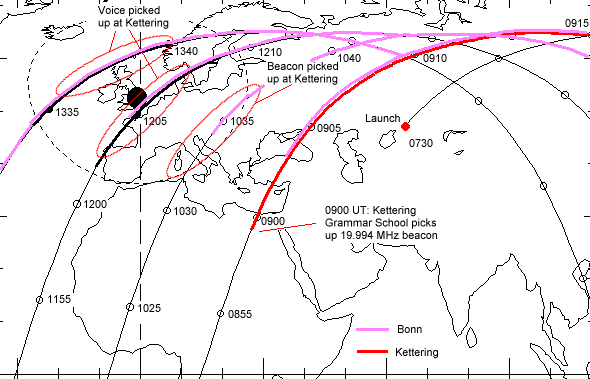
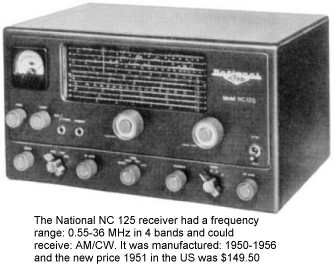
"... I went out to Bivens Arm [the university's radio observatory site outside Gainesville] I think between 8 and 10 AM [The flight was announced at about 4 a.m. local time in Florida] and heard voice on one of the observatory receivers and a big Yagi but didn't have a tape recorder. I think he said "Greeting to American people" - then we picked up the voice and CW that you have on tape in the evening using a dipole antenna and the National NC125 receiver at the Student Satellite Tracking Station [at the campus in Gainesville]. We were trying to get a strip chart record using an old 6 channel Brush recorder but the ink wouldn't flow so we were blowing into the ink reservoir thru a piece of insulation spaghetti. I have no recollection if we got it working or what ever happened to the trace. The tape was recorded on my old Revere reel to reel machine..."
The voice and CW that is referred to above are the beautiful voice transmission from Vladimir Komarov and also the hand-keyed Morse code signals from Komarov that reads: WZN 2 DE RUN QSA 5 DE RUN K. The interpretation of the Morse code is probably: WZN 2 ="Vjezna 2", a short-wave ground station, DE="From" in normal morse-code parlance, RUN=probably means "Rubin", Russian for "Ruby", Komarov's call-sign, QSA 5=The international Q-signals system is used here by Komarov. QSA 5 means "the strength of your signals is very good"! (2), K=Means simply "over" in normal morse-code parlance. So, the whole transmission reads "Vjezna 2, This is Ruby. I hear you very well. This is Ruby. Over."
The map to the left
below
shows the passes near Gainesville when the "greetings to the United
States"
were sent by Komarov. Even if Richard Flagg seems to remember that the
radio call from Komarov between 8 and 10 a.m. (1300-1500 UT), it could
have been as late as 1130 a.m. (1630 UT) when the spacecraft passed
right
over the eastern parts of the United States. The map on the right shows
the "evening" passes near Florida. Possibly the 0155 UT pass near
Gainesville
(8.55 p.m. local time) was the pass on which the voice and Morse code
(see
links above) were recorded.
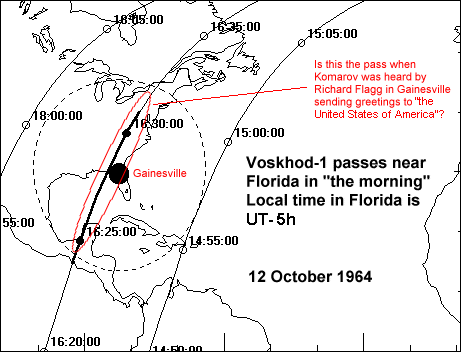 |
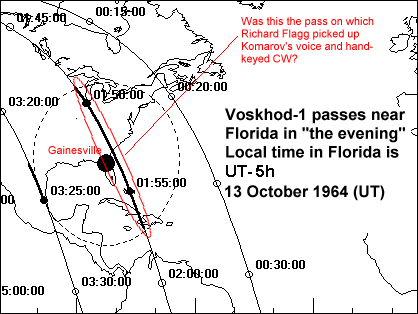 |
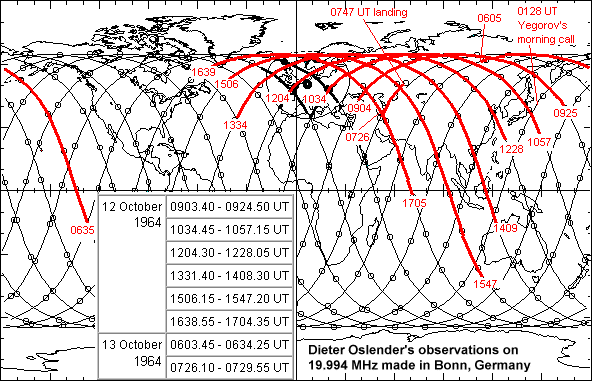
Kamanin writes that there was no report on shortwaves from the spacecraft about the operation of the retro-rocket. Instead this had to come from a tracking ship off the "African coast" (7) (This must have been the east African coast). However, this report was incomplete and it was not until Krug short-wave direction finders ("Krug"=circle) could pick up the capsule beacon as it passed over the Caucasus (7) that confirmation of the correct initiation of landing sequence was received. But the beacon from an antenna in the parachute shroud lines could not be heard and everyone held their breath until a pilot reported seeing an object "in the air, 40 kilometres east of Maryevka" and "two parachute canopies". Finally the same pilot reported seeing the three crewmen standing outside the craft waving their arms. The spacecraft landed at 0747:03 UT at a spot 312 km northeast of Kustanay in Kazakhstan, and he successful conclusion of the flight was announced by Soviet media at 0900 UT.
When the crew arrived
at
Kustanay there was no telephone call from Khrushchev and they flew on
to
Baikonur to report about the flight, which they did the following day.
After a celebratory luncheon at the launch site Marshal Rudenko17
was ordered to fly to Moscow immediately. A plenary of the party
central
committee was to be held the same evening. As General Kamanin puts it
in
his diary:
"It seemed from everything that something unusual was happening
in Moscow". The crew's report at Red Square was cancelled and
Korolev
quietly left the cosmodrome for Moscow on 15 October. Khrushchev - the
chief political supporter of space stunts had been ousted!
The Voskhod-1 crew finally left the launch site and flew to Moscow on
19
October 1964 and were greeted by the new leader Leonid Brezhnev. A
flight
that had been designed to politically eclipse the Americans was
eclipsed
itself by political events in the Soviet Union!